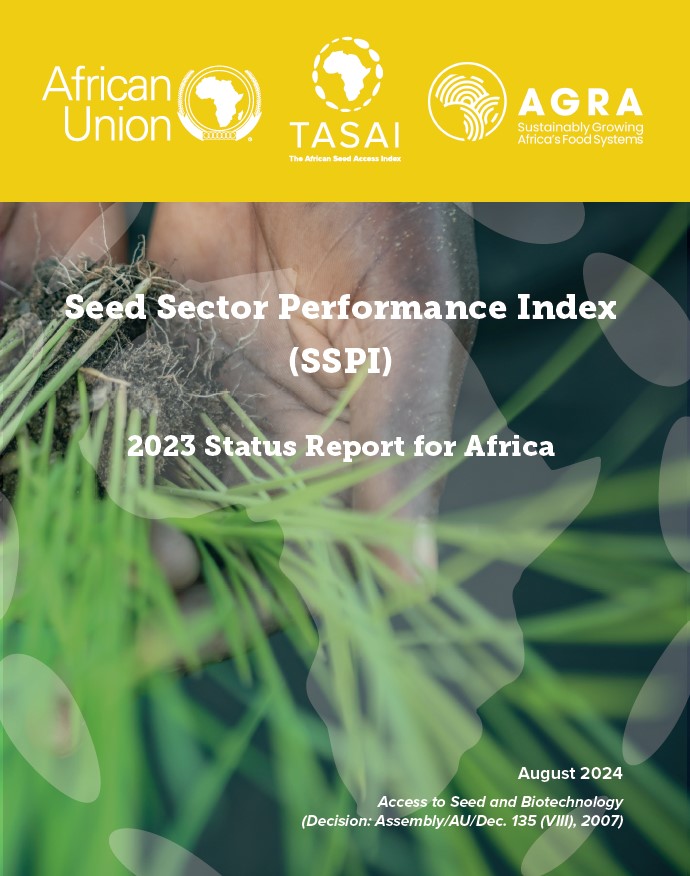Seed Sector Performance Index (SSPI)
The 2023 Seed Sector Performance Index (SSPI) report provides an overview of the performance of national seed sectors in Africa.
Developed by TASAI Inc., in collaboration with the African Union Commission's African Seed and Biotechnology Program (ASBP) and AGRA, the SSPI is a new analytical tool that aims to provide a single score measurement of the health of seed systems across Africa.
The current report is SSPI's first (pilot) report. The 2023 SSPI report shares data from 47 countries on 17 indicators that evaluate key aspects of each country's formal seed system.
The website allows users to access individual country reports and visualize country scores by indicator.
SSPI Indicators
Clicking on the indicators below will reveal a map with each country's score as well as a brief description of the indicator.
This indicator tracks the number of varieties of the top four priority cereal and legume food security crops released in the last 3 years, offering a good measure of outputs from the variety development and release system. More varieties released often translates to more varieties commercialized, thereby increasing farmers' choice. Data sources are national variety catalogues and regional variety catalogues.

This indicator assesses the existence and functioning of a national program (which may include an institute, department, or agency) mandated to carry out or coordinate activities related to PGRFA. These activities include the management of any in-situ conservation area and/or ex-situ conservation facility, such as a national gene bank. The data sources for this indicator are the national entities mandated to coordinate PRGA activities (Food and Agriculture Organisation (FAO) 1997).

This indicator tracks the level of satisfaction with the availability of EGS as reported by seed experts. The ratings measure satisfaction with the availability of EGS to meet certified seed production needs based on (1) the quantity of the EGS supplied, (2) the quality of the EGS, and (3) the timeliness of delivery of the EGS. Data sources are TASAI, where

This indicator tracks the adequacy of the agro-dealer (or seed seller) network in a country. Information on the number of agro-dealers is also provided. The two provide a proxy measure for the robustness of the agro-dealer network. Data is sourced from national seed authorities and the Ministry of Agriculture.

This indicator tracks the extent to which seed is available in small packages, which tend to be more suitable and affordable for small-scale farmers. Small packages may also help increase adoption rates of improved seed among this group. Data sources are TASAI reports, seed industry experts, national seed authorities, and national seed associations.

This indicator tracks the status of national seed policy instruments (seed policies, laws, regulations and decrees) that promote an enabling environment for a competitive seed sector and encourage private sector participation in seed sector development. The indicator does not track the implementation of said policy instruments. Data sources are national seed authorities and the Ministry of Agriculture.

This indicator measures the extent to which national seed regulations are harmonized with the regulations of the respective regional economic communities (RECs), i.e., COMESA, ECOWAS, and SADC. Note that there are countries that are members of more than one REC. Data sources are national seed authorities, and the Ministry of Agriculture.

This indicator measures the extent to which a country has adopted national biosafety frameworks including agricultural biotechnology policies, laws, and/or regulations, and whether these frameworks are operational. Data sources are the National Biosafety Authority, the Africa Agricultural Technology Foundation (AATF), and the Ministry of Agriculture.

This indicator tracks the extent to which national seed policy instruments (seed policies, laws, regulations and decrees) recognize FMSS and promote institutional arrangements that create an enabling environment for FMSS in seed sector development. Note that the indicator tracks the status of these instruments and not their implementation. Data sources are national seed authorities, and the Ministry of Agriculture.

This indicator measures the performance of the national seed trade association. It assumes that well-functioning national seed trade associations play a key role in developing a country's seed sector, as they represent the interests of the industry and are an important liaison between the government and private sector. Data sources are the national seed association, the national seed authority, and TASAI reports, where available.

SSPI Country Reports
The map below displays the overall country scores; hovering over the country provides a link to the detailed country report.
Please select a country to download its detailed report.
For a better user experience, an interactive map is also available on larger screens.







